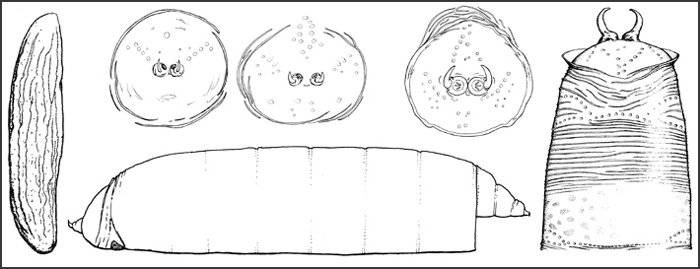 |
 |
 |
|||||||||||||||||||||||||||||||||
 |
|||||||||||||||||||||||||||||||||||
Immature StagesEggs. Eggs are translucent, usually three to four times longer than wide, and approximately as long as sternite 6 of the female (Lonsdale & Marshall, in press). Both ends are tapered (most pronounced anteriorly) and the micropyle is small and terminal. The surface of the egg is usually minutely tuberculate with (usually) no more than a dozen longitudinal wrinkles, but there are numerous departures from this generalized state. In Sobarocephala, these wrinkles are bordered by larger quadrate tubercles, and some of the wrinkles are branched. Larvae. Larvae are known from European Clusiodes Coquillett. The cephalic papillae are minute, the mandibles are small and well sclerotized, and the cephalopharyngeal skeleton is vestigial and unpigmented (Soós, 1987). The anterior spiracles have six openings, each on a small raised tubercle (Soós, 1987). The posterior spiracles are elevated on chitinized plates, produced as dorsally curving hooks with three elongate-oval openings on the medial or ventral half (Malloch, 1918). The anal plate is large, heavily sclerotized, wider than long and tapered laterally (Malloch, 1918). Puparia. Puparia (known from temperate Clusia Haliday, Sobarocephala and Clusiodes) are brownish-orange in colour and covered with numerous minute transverse wrinkles (Lonsdale & Marshall, in press). The posterior face is smooth with various sculpturing, and either sharply curved and bordered by a high ridge (Clusia and Sobarocephala), or broadly rounded with the ridge broken and shallow (Clusiodes). The anal hooks curve dorsally (Clusiodes) or dorsomedially, and are ovate (Clusia) or semi-circular (Sobarocephala) in cross-section. The puparium of the Australian Heteromeringia norrisi is unusual in having an additional inner triangular process on the posterior spiracles. 
Eggs, Heteromeringia spp.
|
|||||||||||||||||||||||||||||||||||
 |
 |
 |
 |
 |
 |
||||||||||||||||||||||||||||||
 |
|||||||||||||||||||||||||||||||||||
